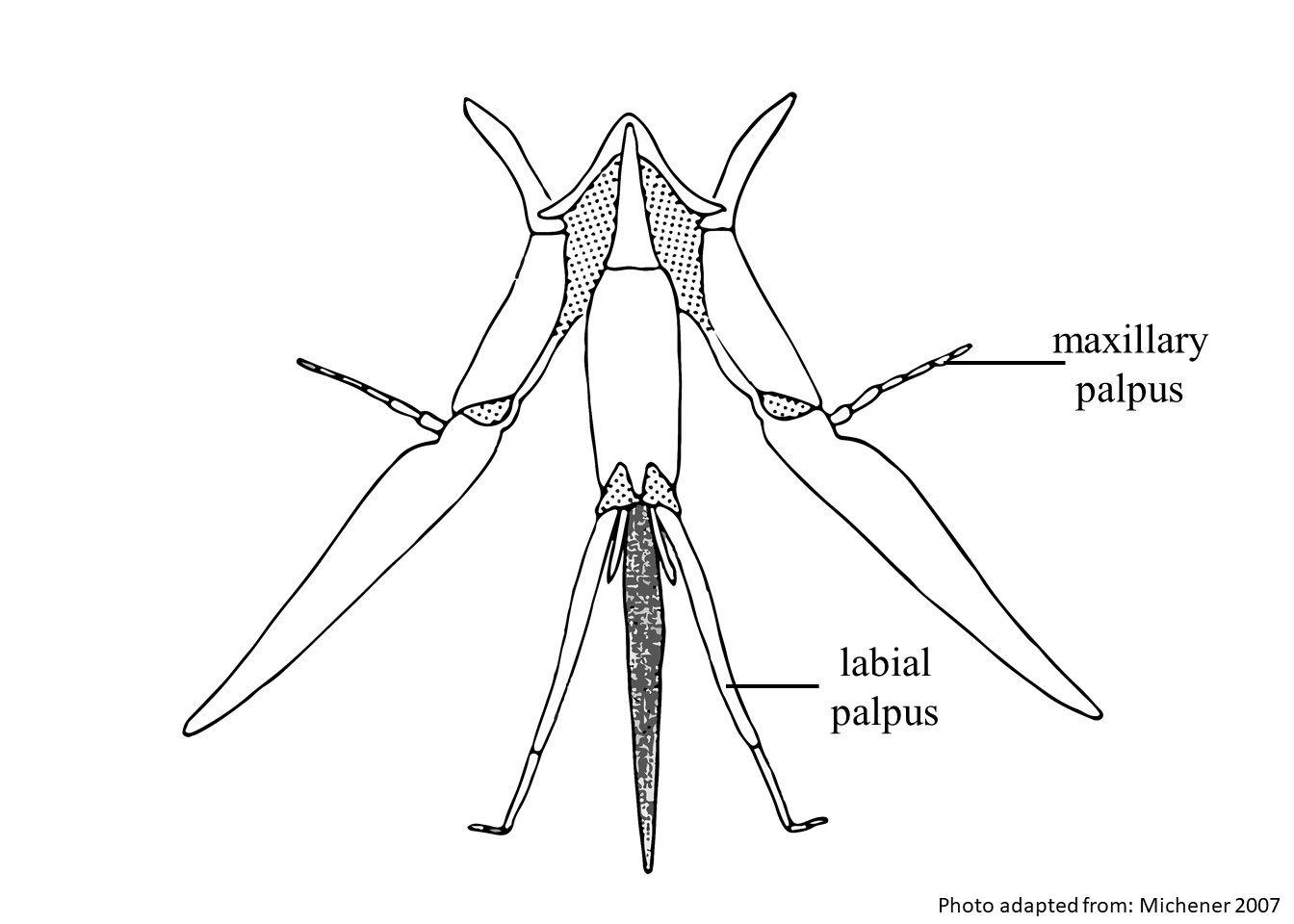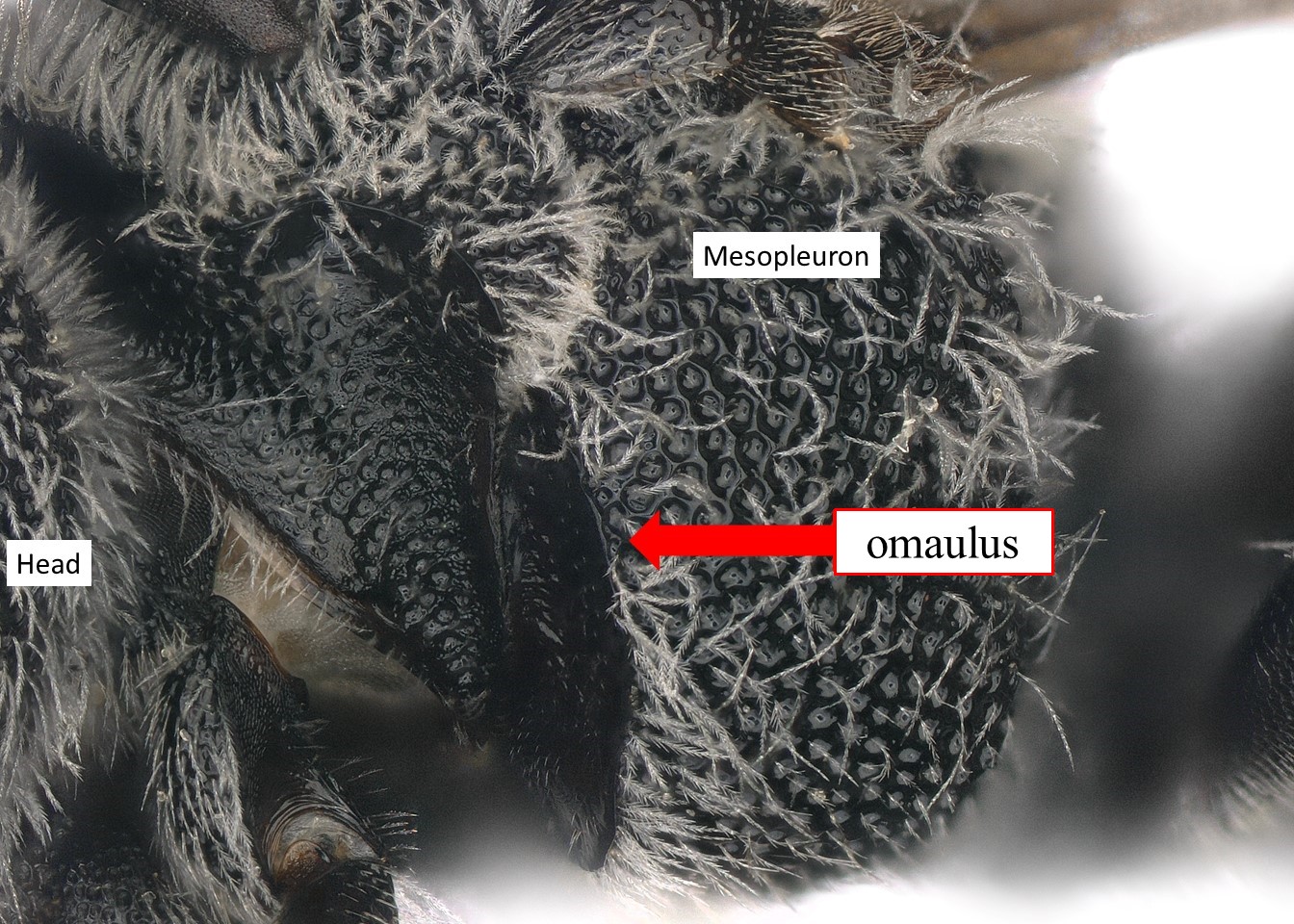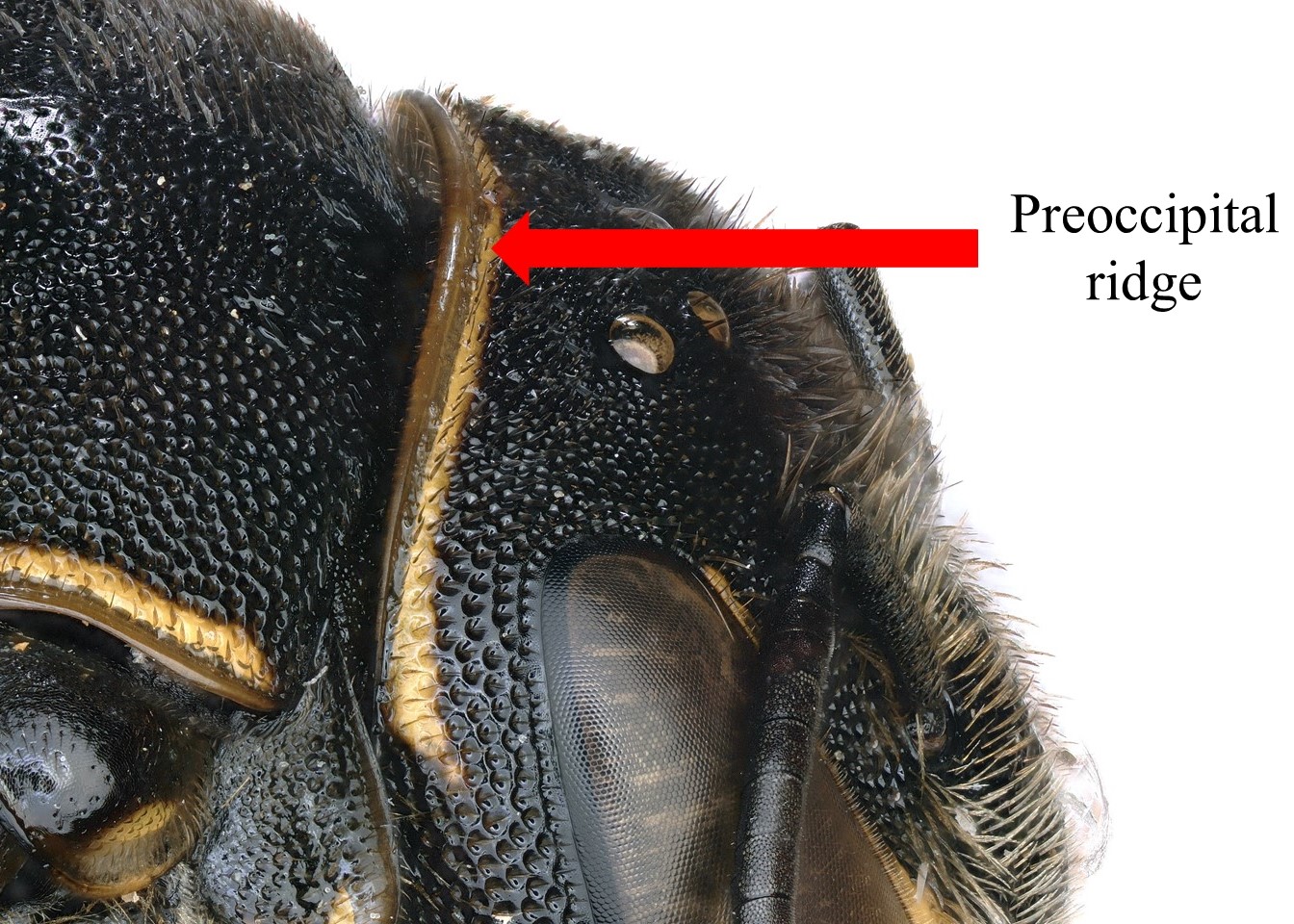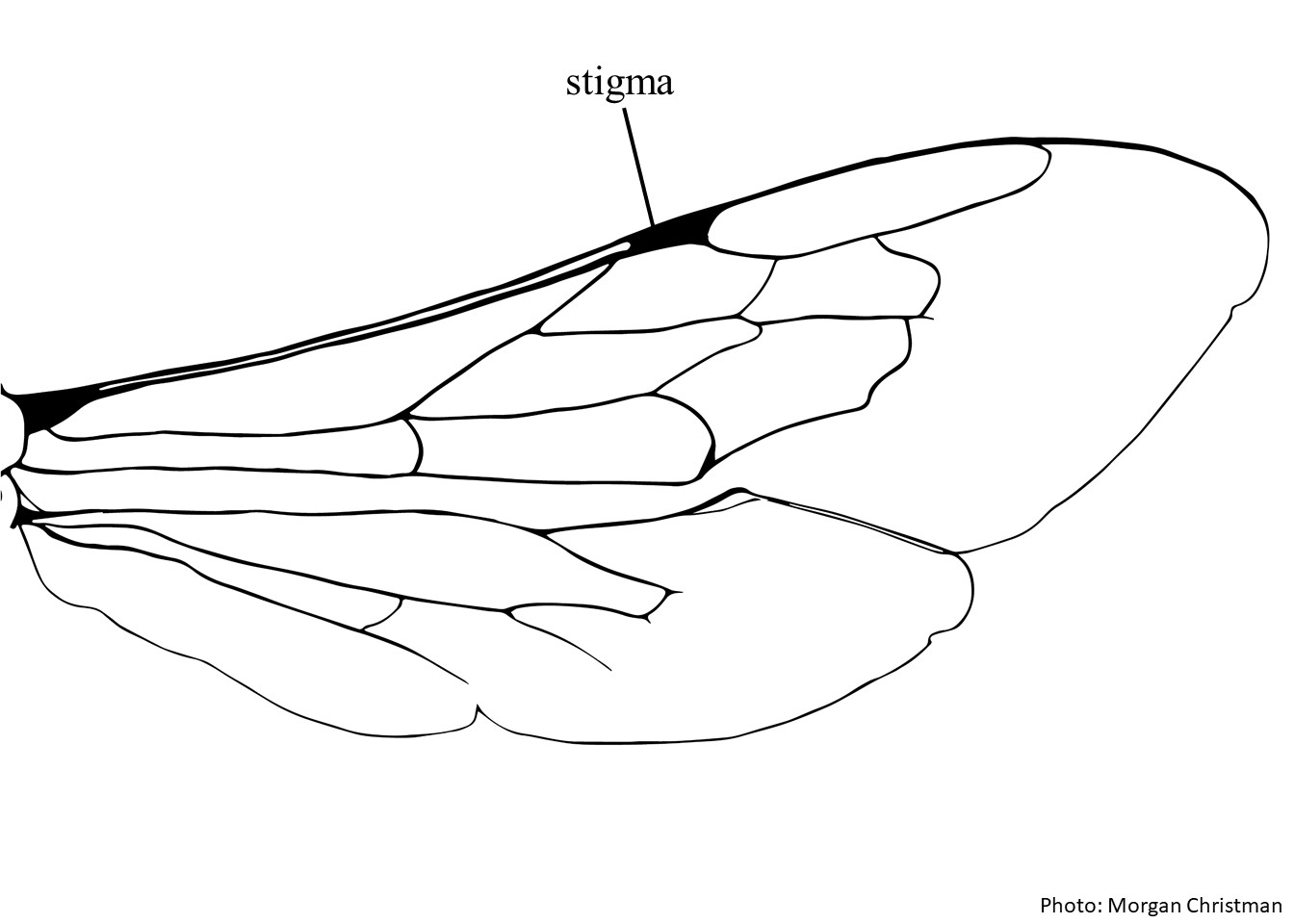Family: Megachilidae
Subfamily: Megachilinae
Tribe: Anthidiini
Genus: Trachusa Panzer, 1804
Subgenera: Archianthidium, Congotrachusa, Heteranthidium, Legnanthidium, Massanthidium, Metatrachusa, Orthanthidium, Paraanthidium, Trachusa, Trachusomimus, Ulanthidium
Common name: “handsome bee” (Trachusa larreae)
Trachusa means “roughened,” which they were likely named after due to the coarse punctations covering their thorax (Wilson and Carril 2016Wilson and Carril 2016:
Wilson, J.S. and O.M. Carril. 2016. The Bees in Your Backyard: A Guide to North Americarsquo;s Bees. Princeton University Press, Princeton and Oxford, 288 pp.). Trachusa are medium to large bees, ranging in body length from 8.5–20 mm, that are sometimes hairy (Michener 2007Michener 2007:
Michener, C.D. 2007. The Bees of the World (2nd ed.). Johns Hopkins University Press, Baltimore and London, 953 pp.). Trachusa is thought to have the most primitive characteristics of all Anthidiini (Michener 1941Michener 1941:
Michener, C.D. 1941. A synopsis of the genus Trachusa with notes on the nesting habits of T. perdita . Pan-Pacific Entomologist 17: 119ndash;125.). Unlike most other anthidiines, Trachusa spp., aside from those in the subgenus Heteranthidium, lack yellow or white maculations on their body (Michener 2007Michener 2007:
Michener, C.D. 2007. The Bees of the World (2nd ed.). Johns Hopkins University Press, Baltimore and London, 953 pp.).
Trachusa contains 52 species in 11 subgenera worldwide (Michener 2007Michener 2007:
Michener, C.D. 2007. The Bees of the World (2nd ed.). Johns Hopkins University Press, Baltimore and London, 953 pp.). There are 19 species known from North America.
(modified from Michener 2007Michener 2007:
Michener, C.D. 2007. The Bees of the World (2nd ed.). Johns Hopkins University Press, Baltimore and London, 953 pp. unless otherwise stated)
 with five segments (Michener 1948Michener 1948:
with five segments (Michener 1948Michener 1948: rounded.
rounded. rounded.
rounded. less than twice as long as broad.
less than twice as long as broad. complexly angled, but not bilobed.
complexly angled, but not bilobed.Most Trachusa can be distinguished from other anthidiines by their lack of maculations (except for in subgenus Heteranthidium) (Michener 1941Michener 1941:
Michener, C.D. 1941. A synopsis of the genus Trachusa with notes on the nesting habits of T. perdita . Pan-Pacific Entomologist 17: 119ndash;125.; Michener 1948Michener 1948:
Michener, C.D. 1948. The generic classification of the anthidiine bees (Hymenoptera: Megachilidae). American Museum of Natural History, New York.). The lack of carinae and the blunt projection on the front tibiatibia:
the segment of the leg, between the femur and the tarsus can help separate Trachusa from other robust anthidiines (Michener 2007Michener 2007:
Michener, C.D. 2007. The Bees of the World (2nd ed.). Johns Hopkins University Press, Baltimore and London, 953 pp.).
There are no known invasives.
Trachusa have been observed visiting a wide variety of different flowers, including Triteleia ixiodes, Rhamnus crocea (nest material), Larrea spp., as well as plants in the families Lamiaceae, Leguminosae, Asteraceae, and Dipsacaceae. T. larreae, however, is specialized on Larrea tridentata (Cane 1996Cane 1996:
Cane, J.H. 1996. Nesting resins obtained from Larrea pollen host by an oligolectic bee, Trachusa larreae (Cockerell). Journal of the Kansas Entomological Society 69: 99ndash;102.).
Trachusa are solitary bees which dig their own nests in the ground (Michener 2007Michener 2007:
Michener, C.D. 2007. The Bees of the World (2nd ed.). Johns Hopkins University Press, Baltimore and London, 953 pp.). Trachusa perdita nests consist of a single, broadly curved tunnel dug into loose, sandy soil (Michener 1941Michener 1941:
Michener, C.D. 1941. A synopsis of the genus Trachusa with notes on the nesting habits of T. perdita . Pan-Pacific Entomologist 17: 119ndash;125.). The nest cells that have been studied are made up of irregularly cut pieces of Rhamnus crocae and are cemented to the sides of the tunnel with a resinous gum (Cane 1996Cane 1996:
Cane, J.H. 1996. Nesting resins obtained from Larrea pollen host by an oligolectic bee, Trachusa larreae (Cockerell). Journal of the Kansas Entomological Society 69: 99ndash;102.). In contrast, T. bysinna have been observed nesting in groups of as many as fifty females, with nests that sometimes have branching tunnels rather than the single curved tunnels of T. perdita. The nesting biology of T. (Heteranthidium) larreae has been well described (MacSwain 1946MacSwain 1946:
MacSwain, J.W. 1946. The nesting habits of Heteranthidium larreae . Pan-Pacific Entomologist 22: 159ndash;160.; Cane 1996Cane 1996:
Cane, J.H. 1996. Nesting resins obtained from Larrea pollen host by an oligolectic bee, Trachusa larreae (Cockerell). Journal of the Kansas Entomological Society 69: 99ndash;102.; Rozen and Hall 2012Rozen and Hall 2012:
Rozen, J.G. and G.H. Hall. 2012. Nesting biology and immatures of the oligolectic bee Trachusa larreae (Apoidea: Megachilidae: Anthidiini). American Museum Novitates 3765: 1ndash;24.). Trachusa larreae surrounds the entrance of its nest with pebbles and twigs. The nest tunnels are about 7 mm in diameter and 8–19 cm long (MacSwain 1946MacSwain 1946:
MacSwain, J.W. 1946. The nesting habits of Heteranthidium larreae . Pan-Pacific Entomologist 22: 159ndash;160.; Cane 1996Cane 1996:
Cane, J.H. 1996. Nesting resins obtained from Larrea pollen host by an oligolectic bee, Trachusa larreae (Cockerell). Journal of the Kansas Entomological Society 69: 99ndash;102.). The nest tunnels are unbranched and descend at a 25°–30° angle with the soil for several cm before turning abruptly at a 45° angle and opening to an entrance chamber from which the nest cells radiate. The walls of the cells are made up of a greyish-green resin mixed with soil (Cane 1996Cane 1996:
Cane, J.H. 1996. Nesting resins obtained from Larrea pollen host by an oligolectic bee, Trachusa larreae (Cockerell). Journal of the Kansas Entomological Society 69: 99ndash;102.). Isolated nests of T. larreae have been found, as well as huge perennial nesting aggregations spanning as much as 95 m long (Cane 1996Cane 1996:
Cane, J.H. 1996. Nesting resins obtained from Larrea pollen host by an oligolectic bee, Trachusa larreae (Cockerell). Journal of the Kansas Entomological Society 69: 99ndash;102.).
Trachusa are widespread across North America, Europe, Africa, and Asia (Michener 2007Michener 2007:
Michener, C.D. 2007. The Bees of the World (2nd ed.). Johns Hopkins University Press, Baltimore and London, 953 pp.).
Distribution map generated by Discover Life - click on map for details, credits, and terms of use.
Cane, J.H. 1996. Nesting resins obtained from Larrea pollen host by an oligolecticoligolectic:
the term used to describe bees that specialize on a narrow range of pollen sources, generally a specific plant genus
bee, Trachusa larreae (Cockerell). Journal of the Kansas Entomological Society 69:99–102.
MacSwain, J.W. 1946. The nesting habits of Heteranthidium larreae. Pan-Pacific Entomologist 22:159–160.
Michener, C.D. 1941. A synopsis of the genus Trachusa with notes on the nesting habits of T. perdita. Pan-Pacific Entomologist 17:119–125.
Michener, C.D. 1948. The generic classification of the Anthidiine bees (Hymenoptera, Megachilidae). American Museum Novitates 1381:1–29.
Michener, C.D. 2007. The Bees of the World (2nd ed.). Johns Hopkins University Press, Baltimore and London, 953 pp.
Rozen, J.G. and G.H. Hall. 2012. Nesting biology and immatures of the oligolecticoligolectic:
the term used to describe bees that specialize on a narrow range of pollen sources, generally a specific plant genus
bee Trachusa larreae (Apoidea: Megachilidae: Anthidiini). American Museum Novitates 3765:1–24.
Wilson, J.S. and O.M. Carril. 2016. The Bees in Your Backyard: A Guide to North America’s Bees. Princeton University Press, Princeton and Oxford, 288 pp.